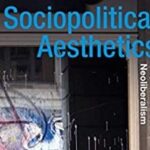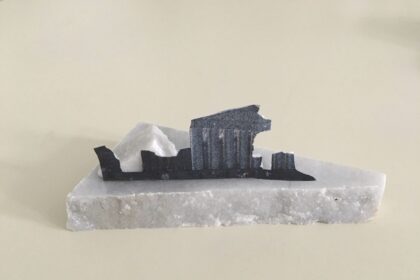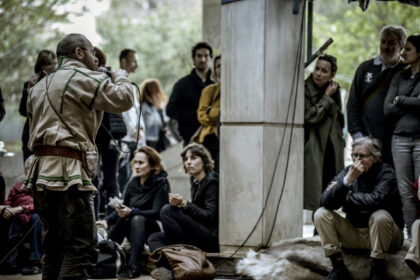Editorial | Spring-Fall 2021
Welcome to issue 18-19 of FIELD. This is a special double issue that represents the culmination of Learning from documenta (Lfd), a long-term investigation into documenta 14 (2017) that we began in issue 11 (Fall 2018). While the biennial format has a long history (the first Whitney Biennial opened in 1933 and documenta was launched in 1955 as part of the Federal Horticulture Show in Kassel) it has mushroomed in importance over the past two decades, coincident with the dramatic expansion of the market for contemporary art. In this respect it epitomizes the significant new forms of ideological labor that occur as contemporary art struggles to retain its transgressive aura, even as its subject to unprecedented levels of commodification. The biennial exists in conjunction with the art fair, it’s less prestigious, but equally essential, corollary. It is through the biennial, among other sites, that artists earn the symbolic capital necessary to legitimate the monetization of contemporary art on which the art market itself depends. The interlocking, global network of institutional and discursive structures that we know as the “artworld” (biennials, auction houses, galleries, museums, curators, dealers, etc.) is centrally implicated in this process. The travelling or nomadic biennial has introduced a further inflection of this institutional schema. By moving the biennial out of the privileged cultural centers of Europe and North America, it provides the artworld with controlled access to a new reservoir of symbolic and cultural materials (typically urban spaces defined by a relative lack of economic privilege). This spatial displacement provides the frisson of the social real necessary to maintain the perception that an institutional apparatus that depends on the taste patterns of the 1% can nonetheless maintain an exemplary, critical relationship to global forms of oppression or inequality.
However much biennials claim to employ a collaborative or non-imperial approach to the “off shore” sites in which they chose to operate, they inevitably carry along with them certain colonizing tendencies. In the case of documenta 14 the large curatorial team that descended on Athens in order to “learn” from its unique history and identity seemed strikingly oblivious to the way in which their efforts to intervene in the city’s complex symbolic politics might be perceived. A set of early public programs (“The Parliament of Bodies”) was staged in the former headquarters of the secret police who tortured and killed protestors during the military junta in 1967, an event that is seared into the memories of Greek citizens to the present day. Documenta 14s education workshop was located next to a large gate on the campus of the Athens Polytechnic that was, famously, destroyed by military tanks during the 1973 student-led uprising.[1] Perhaps documenta’s curators imagined they were engaging in a clever form of historical montage by employing these sites, but these gestures were experienced by many in Athens as profoundly insensitive, simultaneously presumptuous and voyeuristic. Moreover, notwithstanding the fact that the d14 team included a number of non-German curators, they failed to appreciate the fact that their financial dependence on documenta (one of the most powerful cultural institutions in Germany) made them de facto cultural emissaries of the FRG which, in its leading position in the E.U. hierarchy, had recently imposed crippling “neo-liberal” austerity measures on the country. Instead of acknowledging their self-evident institutional and geopolitical privilege, the curators become openly defensive when the residents of Athens involved with the Lfd project chose to challenge this privilege in public events. [2] The condescension with which d14’s chief curator Adam Szymzyk sought to differentiate the city of Athens, as the detached object of his entrepreneurial gaze, from the lived experience of it’s actual residents (the “local art scene”) is, of course, symptomatic of precisely the sort of cultural hierarchy that the exhibition, ostensibly, sought to overturn.
As the scholars, activists and artists of Lfd came to realize, conventionally trained artists and curators find it hard to surrender the privilege of transcendence, something which anthropologists have explored for many years in their own discipline. This same tension is evident in a number of the essays included here and in our Fall 2018 issue. It’s exemplified with particular clarity in Grigoris Gkougkousis’s analysis of the complexities raised by Rasheed Araeen’s Shamiyaana installation in Athens’ Kotzia Square, as it sought to reconcile the privileging of affluent art tourists with a utopian appeal to the potential for “social change” generated by a non-hierarchical “gesture of hospitality”. While the biennial as such has been the subject of a number of recent scholarly publications, the research assembled by the Lfd research project represents the first large scale, systematic analysis of a single biennial undertaken by an interdisciplinary team drawn from the arts, humanities and social sciences. The initiative was launched by Elpida Rikou and Eleana Yalouri, two leading figures in the ongoing dialogue between art practice, art history and anthropology in Greece. FIELD is honored to provide a platform for this important, and extensive, study (it features almost forty essays over the two dedicated issues). We would like to extend our gratitude to the editors of this special issue, Elpida, Eleana and Apostolos Lampropoulos, as well as our many contributors, for their generosity and insight.
Notes
[1] See Cathryn Drake, “Here’s Why Greece Is Not Exactly Rolling Out the Red Carpet for documenta 14,” Artnet.Com (March 29, 2017). https://news.artnet.com/art-world/greece-not-rolling-out-red-carpet-documenta-14-905459
[2] See Elpida Rikou, “Recovering Lost Voices: A Situated Perspective on documenta 14” and Eleana Yalouri, “Art Meeting Anthropology: Affective Encounters,” in this issue











